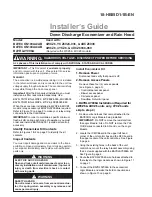
Apply putty here
Tubing
Fig. 45
Fig. 44
Clamp
Insulated tubes
Insulation
Min.
5/16"
Thickness:
min. 5/16"
21
8-6. Connecting Tubing between Indoor and
Outdoor Units
a)
Tightly connect the indoor side refrigerant tubing
extended from the wall with the outdoor side tubing.
(Fig. 41)
b)
To fasten the flare nuts, apply specified torque as:
Table 6
8-7. Insulation of Refrigerant Tubing
(For C2462R and CL2462R)
To prevent heat loss and wet floors due to dripping of
condensation, both tubes must be well insulated with
a proper insulation material. The thickness of the insu-
lation should be a minimum 5/16" (Fig. 43)
8-8. Taping the Tubes
(1) At this time, the 2 refrigerant tubes (and electrical wire
if local codes permit) should be taped together with
armoring tape. The drain hose may also be included
and taped together as 1 bundle with the tubing.
(2) Wrap the armoring tape from the bottom of the out-
door unit to the top of the tubing where it enters the
wall. As you wrap the tubing, overlap half of each
previous tape turn. (Fig. 44)
(3) Clamp the tubing bundle to the wall, using 1 clamp
approx. every 4 ft.
Do not wind the armoring tape too tightly since this will
decrease the heat insulation effect. Also be sure the
condensation drain hose splits away from the bundle
and drips clear of the unit and the tubing.
8-9. Finishing the Installation
After finishing insulating and taping over the tubing, use
sealing putty to seal off the hole in the wall to prevent
rain and draft from entering. Fig. 45 shows refrigerant
tubing taped separately from the drain hose.
NOTE
IMPORTANT
Indoor unit
Outdoor unit
Spanner
Torque wrench
Fig. 41
Insulation
(Field supply)
Fig. 42
Fig. 43
Tube Dia.
Tightening Torque
3/8"
Approx. 300 – 340 lbs..in (35 – 40 N.m)
3/4"
Approx. 870 – 1,040 lbs..in (100 – 120 N.m)
CAUTION
After a tube has been insulated,
never try to bend it into a nar-
row curve, as this may cause
the tube to break or crack.
02-291AirCon Final 12/11/02 2:46 PM Page 21











































